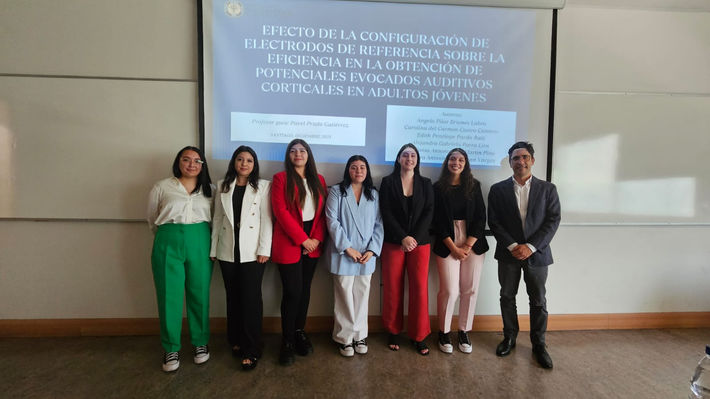top of page

KMP
Pavel Prado personal web page


Thesis 2023
Two dissertations explored how the selection of the reference system during the EEG acquisition impacts electrophysiological outcomes in audiology, e.g., the recording efficiency of cortical auditory evoked potentials and the estimation of the cortical generator of the auditory response.
Efficiency of Obtaining Cortical Auditory Evoked Potentials in Young Adults: Effect of Reference Electrode Configuration
The Cortical Auditory Evoked Potential (CAEP) is widely used in research and practice to monitor the effectiveness of speech therapies and interventions. The CAEP results from repetitively presenting auditory stimuli and averaging equivalent electroencephalogram (EEG) segments, called epochs. Achieving efficient CAEP analysis requires developing methodologies that minimize averaging. This is necessary to reduce the duration of speech therapy tests, especially when the study populations consist of young children and individuals with cognitive disabilities who do not consistently respond to traditional behavioral assessments. This study expands on previous research, analyzing the effect of the reference electrode system used during EEG acquisition on CAEP efficiency in 35 normal-hearing adults (age 24±3 years). CAEP was recorded with 64 electrodes, and three reference types were tested: average, Cz, and mastoids' average. To assess efficiency, we examined the similarity between the CAEP attained by averaging different numbers of epochs (ranging from 2 to 80) and the one acquired by averaging 80 epochs. It was considered that CAEP does not vary significantly after 80 averages. Similarity was estimated using the Pearson correlation coefficient, which takes values between 0 and 1, indicating no and complete similarities, respectively. The amplitude and topographical distribution of CAEP depended on the EEG reference.Additionally, the reference significantly influenced the efficiency of CAEP acquisition. The efficiency achieved with the average reference was higher than that obtained with the Cz and the average of mastoids. Furthermore, the efficiency achieved with the Cz reference did not statistically differ from that achieved with the average of the mastoids. This study highlights the benefit of using the average reference in speech therapy tests involving high-density EEG electrode configurations. The study also suggests that slightly increasing the number of electrodes in clinical settings, and the subsequent implementation of the average reference, may increase efficiency in obtaining auditory evoked potentials.
Effect of Reference Electrode Configuration on the Estimation of Neuronal Generators of Cortical Auditory Evoked Potential in Young Adults
This research analyzed the brain generators of Cortical Auditory Evoked Potentials (CAEP) based on the reference electrode system used during electroencephalogram (EEG) acquisition. This type of evoked potential is highly relevant in audiology, both from an experimental and clinical perspective, as it allows monitoring the effectiveness of therapies and interventions related to auditory function recovery and speech acquisition/comprehension. Therefore, it is crucial to develop analysis methods that, based on EEG, accurately estimate the cortical activation map associated with CAEP generation. Considering that the reference electrode system affects the amplitude and morphology of CAEP, does it also influence the cortical activation map associated with its generation? We analyzed the CAEP of 26 young, right-handed, normal-hearing adults to answer this question. The EEG was acquired from 64 scalp locations. The electrodes were placed according to the international 10-20 system. Subsequently, four reference systems were tested: the average of the mastoids, the average of all electrodes, Cz, and the average of two electrodes positioned on frontal areas (the frontal average). An inverse solution method for EEG (LORETA) was employed to convert voltages recorded on the scalp into electrical currents in the brain, generating cortical activation maps.To determine the most suitable reference type, we consider it a ground truth that cortical maps should accurately reflect activation in the temporal lobe, ideally in the primary auditory cortex. The results illustrated that the CAEP cortical activation map depended on the choice of reference system for the EEG acquisition. The most suitable reference configuration for the study of CAEP was the average reference, followed by the average of central electrodes and the average of mastoids. The least suitable was the Cz reference. These findings contribute to developing speech therapy tools to have markers of brain activity as a clinical criterion for selecting cochlear implant candidates and monitoring brain maturation processes and speech-related speech therapy interventions.

Celebrating succes after work
Congratulations to
Angela Pilar Briones Labra
Carolina del Carmen Castro Cantero
Edith Penelope Pardo Ruiz
Alejandra Gabriela Parra Lira
Estefanía Antonia San Martín Pino
Tamara Antonia Weidmann Vargas
Congratulations to
Daniela Andrea González Lara
Sofía Belén Orellana Águila
Mackarena Francisca Roco López
Constanza Jesús Sandoval González
Carla Andrea Silva Vega

bottom of page





